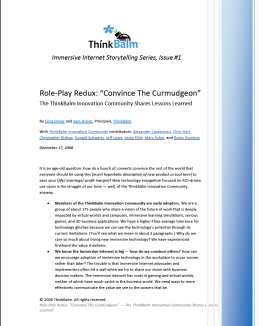I recently spoke with three business decision makers who have been involved with deployment of pseudo-3D immersive environments in their organizations or for their customers. I spoke with Michael Doyle, executive director and editor of the Virtual Edge Institute; Kate Spellman, senior VP and managing director of UBM Studios; and Caroline Avey, director of innovative learning solutions at ACS Learning Services. We talked about why they are using pseudo-3D immersive technology rather than alternatives.
Pseudo-3D is used for conferences and trade shows—but it doesn’t stop there
When you think of virtual event platforms from companies like InXpo, ON24, and Unisfair, what likely comes to mind is large virtual conferences and trade shows. Here are a couple of examples:
- The Virtual Edge Summit. This conference, which was focused on virtual events, meetings and communities, was held over two days in February, 2010—both online and in Santa Clara, California. Michael Doyle, the executive director of the Virtual Edge Institute, said that 400 people attended in person and 600 attended online.
- COMDEX. COMDEX was a computer industry trade show last held in 2003. The event had become massive, with more than 200,000 visitors and 2,300 exhibitors. UBM Studios will bring COMDEX back this November as an online event focused on the show’s original audience: the high tech channel. Kate Spellman, senior VP and managing director of UBM Studios, said they expect to have about 35 exhibitors and 3,000 attendees.
While large conferences and trade shows certainly represent the bulk of usage to date, we’re starting to organizations use pseudo-3D immersive software software in other innovative ways. For example, ACS Learning Services held a launch event in January, 2010 for a new company-wide innovation program that leverages an idea management system. The company deployed the Unisfair platform for the launch event and now is leaving it up and running, for one year, to function as a portal for employees who want to learn about the innovation program and the idea management system. The idea behind the portal is to enable self-directed, discovery-based learning, a place to launch the program, a vehicle for social-networking to discuss ideas, and a front door to the formal learning via a deep link to both the learning management system and the idea generation system. The Unisfair platform provides a level of engagement above and beyond what people get from just the learning management system and a webinar.
Pseudo-3D technology meets requirements for scale and ease of use
Vendors like InXpo, ON24, Unisfair and others offer pseudo-3D immersive environments that can scale to tens of thousands of simultaneous users by giving participants the illusion that they are in a 3D environment, rather than delivering a full 3D experience. (See the related March 26, 2010 ThinkBalm blog article, “Pseudo-3D is a rising star, keeping barriers to adoption low.”) In a nutshell:
- Hundreds or thousands of event attendees requires a highly scalable solution. About 600 people attended Virtual Edge Institute’s Virtual Edge Summit online, accompanying another 400 who attended physically. UBM Studios is expecting 35 exhibitors and about 3,500 attendees at this fall’s COMDEX trade show. Caroline Avey, director of innovative learning solutions at ACS Learning Services, said, “Because we have 15,000 employees located in 170 countries, there is just no way we could have brought everyone together for a physical launch event.” None of the 3D immersive technologies can support this number of simultaneous users being in the same virtual place at the same time.
- Ease of use sometimes means that browser-based technology is the only real option. At ACS Learning Services, the project team had only six weeks to create the learning objects, design the experience, and customize the Unisfair environment. This required a solution that was simple to configure and deploy. Also, the team had limited insight into the computer setups and Internet access of employees around the globe. This required that a solution that adhered to the least common denominator; it had to be Web-based, with no plug-in.
Hybrid events will move beyond parallel experiences as technology and behavior evolve
A hybrid event is a meeting, conference, or trade show that some speakers and audience members attend physically while others attend virtually. Due to technical complexity and the habits of presenters and attendees, hybrid events are largely parallel events today. Networking activities are segregated: people attending physically mingle amongst themselves, apart from remote attendees. Speakers tend to address one audience or the other (physical or virtual)—not both at the same time.
With the Virtual Edge Summit, which took place in February, 2010, the Virtual Edge Institute has started to tackle some of these issues by:
- Connecting attendees with electronic communication tools. The event producers set up a Twitter hashtag (#ve10) and encouraged attendees to tweet throughout the event. The producers set up a dedicated screen in some of the meeting rooms to display tweets in real-time, and tried to incorporate tweets into the Q&A discussion. InXpo, one of the virtual event platforms used during the Virtual Edge Summit, provides voice over IP integration with Skype, which enabled participants who were attending via InXpo Virtual Events Platform to communicate with each other via text, voice, or video chat. But participants attending via other virtual event platforms, or in person, had no way of joining in on these Skype conversations.
- Attempting to cross the visual divide. The producers streamed video of speakers presenting remotely into the physical meeting room, where it was displayed on a screen. Likewise, presentations that took place on-site were streamed out to the virtual environments. Participants attending remotely could watch live video of the speakers presenting. This visual integration was limited to the presenters only. The on-site and remote audiences had no visual connection to each other.
My take: pseudo-3D immersive technology meets some burning business needs
My conversations with these early adopters confirm what I’ve been hearing from others. First, pseudo-3D technology meets requirements for scale and ease of use. When it’s not practical or possible to bring thousands of people together physically, pseudo-3D immersive technology provides an alternative. Full 3D solutions cannot scale to meet this need (yet). Second, pseudo-3D immersive technology will increasingly be used not just for large conferences and trade shows but other things as well, such as training. ACS Learning Services’ use of the technology as a learning portal is a great example.
And third, while hybrid events are largely parallel experiences today, they will move beyond this as technology and behavior evolve. I envision a time in the not-too-distant future when the walls of physical meeting rooms will be lined with displays showing the virtual audience’s communications (and avatars, when they exist), and the virtual meeting rooms will display not only streaming video of speakers but of the entire physical audience. Communication tools and networking opportunities will be available to all participants, whether on-site or remote. Speakers will become accustomed to having distributed audiences, and will more naturally be able to include them in their presentations and discussions.

